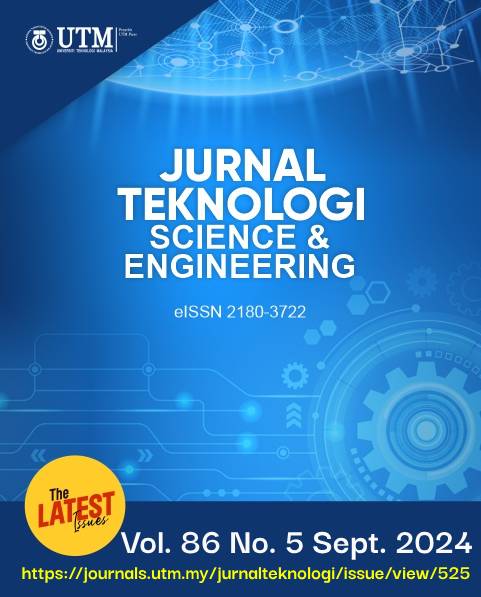NUMERICAL SIMULATION OF UNSTEADY SIGNAL TRANSDUCTION DURING THE FORMATION OF INVADOPODIA USING LEVEL SET METHOD
DOI:
https://doi.org/10.11113/jurnalteknologi.v86.20839Keywords:
Invadopodia formation, signal transduction, unsteady case, free boundary problem, level set methodAbstract
The finger-like protrusions formed by an invasive cancer cell known as invadopodia is actively observed recently because of this formation on the cancer invasion. The signal on the interface which is stimulated upon contact between epidermal growth factor receptor and ligand, is investigated to be the start of invadopodia formation. In this research, a model of invadopodia formation with signal variable is formulated in two dimensions. The plasma membrane is assumed to be free boundary. The signal is in an unsteady state. The equation of signal is represented by heat-like equation with time-dependent boundary condition. Trigonometry types of the boundary condition which are sine and cosine function are tested to identify the most suitable boundary condition represented the free boundary. The plasma membrane is considered as zero level set function. The membrane moves by the velocity of the signal inside the cell. To handle the free boundary problem, the level set method combining features of ghost method, interpolation and extrapolation method is applied to solve the model numerically. Our result shows that the free boundary is moved at different positions and seen to move inward meaning that the boundary has shrunk. Cosine function is discovered to fit the boundary conditions since the boundary solutions are stable across the time. The computation of the signal density profiles displayed highest density on the membrane.
References
Liao, D. and Johnson, R. S. 2007. Hypoxia: A Key Regulator of Angiogenesis in Cancer. Cancer and Metastasis Reviews. 26: 281-290.
DOI: https://doi.org/10.1007/s10555-007-9066-y.
Szabó, A. and Merks, R. M. 2013. Cellular Potts Modeling of Tumor Growth, Tumor Invasion, and Tumor Evolution. Frontiers on Oncology. 3: 87.
Doi: http://dx.doi.org/ 10.3389/fonc.2013.00087.
van Zijl, F., Krupitza, G. and Mikulits, W. 2011. Initial Steps of Metastasis: Cell Invasion and Endothelial Transmigration. Mutation Research/Reviews in Mutation Research. 728(1-2): 23-34.
Doi: https://doi.org/10.1016/j.mrrev.2011.05.002.
Otrock, Z. K., Mahfouz, R. A., Makarem, J. A. and Shamseddine, A. I. 2007. Understanding the Biology of Angiogenesis: Review of the Most Important Molecular Mechanisms. Blood Cells, Molecules, and Diseases. 39(2): 212-220.
Doi: https://doi.org/10.1016/j.bcmd.2007.04.001.
Xue, C., Wyckoff, J., Liang, F., Sidani, M., Violini, S., Tsai, K. L., Zhang, Z. Y., Sahai, E., Condeelis, J. and Segall, J. E. 2006. Epidermal Growth Factor Receptor Overexpression Results in Increased Tumor Cell Motility in Vivo Coordinately with Enhanced Intravasation and Metastasis. Cancer Research. 66(1): 192-197.
Doi: https://doi.org/10.1158/0008-5472.CAN-05-1242.
Saitou, T., Rouzimaimaiti, M., Koshikawa, N., Seiki, M., Ichikawa, K. and Suzuki, T. 2012. Mathematical Modeling of Invadopodia Formation. Journal of Theoretical Biology. 298: 138-146.
Doi: https://doi.org/10.1016/j.jtbi.2011.12.018.
Admon, M. A. and Suzuki, T. 2017. September. Signal Transduction in the Invadopodia Formation using Fixed Domain Method. Journal of Physics: Conference Series. (Vol. 890, No. 1, p. 012036). IOP Publishing.
Doi: http://dx.doi.org/ 10.1088/1742-6596/890/1/012036.
Revach, O. Y. and Geiger, B. 2014. The Interplay between the Proteolytic, Invasive, and Adhesive Domains of Invadopodia and Their Roles in Cancer Invasion. Cell Adhesion & Migration. 8(3): 215-225.
Doi: http://dx.doi.org/ 10.4161/cam.27842.
Sibony-Benyamini, H. and Gil-Henn, H. 2012. Invadopodia: the Leading Force. European Journal of Cell Biology. 91(11-12): 896-901.
Doi: https://doi.org/10.1016/j.ejcb.2012.04.001.
Paz, H., Pathak, N. and Yang, J. 2014. Invading One Step at a Time: The Role of Invadopodia in Tumor Metastasis. Oncogene. 33(33): 4193-4202.
Doi: https://doi.org/10.1038/onc.2013.393.
Wang, Z., Liang, X., Cai, M. and Du, G., 2016. Analysis of Invadopodia Formation in Breast Cancer Cells. Breast Cancer: Methods and Protocols. 203-210.
Doi: https://doi.org/10.1007/978-1-4939-3444-7_18.
Parekh, A. and Weaver, A. M. 2016. Regulation of Invadopodia by Mechanical Signaling. Experimental Cell Research. 343(1): 89-95.
Doi: https://doi.org/10.1016/j.yexcr.2015.10.038.
Admon, M. A. B., 2015. Mathematical Modeling and Simulation in an Individual Cancer Cell Associated with Invadopodia Formation. Doctoral Dissertation. Osaka University.
Azhuan, N. N., Poignard, C., Suzuki, T., Shafie, S. and Admon, M. A. 2019. Two-dimensional Signal Transduction during the Formation of Invadopodia. Malaysian Journal of Mathematical Sciences. 13(2): 155-164.
Yaacob, N., Azhuan, N. A. N., Shafie, S. and Admon, M. A., 2019. Numerical Computation of Signal Stimulation from Ligand-EGFR Binding during Invadopodia Formation. Matematika. 139-148.
Doi: https://doi.org/10.11113/matematika.v35.n4.1268.
Ramlee, M. A., Loling Othman, N. and Suzuki, T. 2023. Invadopodia Formation in Cancer Cell: The Mathematical and Computational Modelling based on Free Boundary Problem. Mathematics. 11(14): 3044.
Doi: https://doi.org/10.3390/math11143044.
Hamidi, M. A., Azhuan, N. A. N., Yaacob, N., Suzuki, T. and Admon, M. A. 2024. Mathematical Modelling and Simulation of Invadopodia Formation due to Ligand and Transmembrane Protein Binding. AIP Conference Proceedings (Vol. 2895, No. 1). AIP Publishing.
Doi: https://doi.org/10.1063/5.0194718.
Gallinato, O., Ohta, M., Poignard, C. and Suzuki, T. 2017. Free Boundary Problem for Cell Protrusion Formations: Theoretical and Numerical Aspects. Journal of Mathematical Biology. 75: 263-307.
Doi: http://dx.doi.org/ 10.1007/s00285-016-1080-7.
Augoff, K., Hryniewicz-Jankowska, A. and Tabola, R. 2020. Invadopodia: Clearing the Way for Cancer Cell Invasion. Annals of translational medicine. 8(14).
Doi: http://dx.doi.org/ 10.21037/atm.2020.02.157.
Linder, S., Cervero, P., Eddy, R. and Condeelis, J. 2023. Mechanisms and Roles of Podosomes and Invadopodia. Nature Reviews Molecular Cell Biology. 24(2): 86-106.
Doi: http://dx.doi.org/ 10.1038/s41580-022-00530-6.
Downloads
Published
Issue
Section
License
Copyright of articles that appear in Jurnal Teknologi belongs exclusively to Penerbit Universiti Teknologi Malaysia (Penerbit UTM Press). This copyright covers the rights to reproduce the article, including reprints, electronic reproductions, or any other reproductions of similar nature.
















